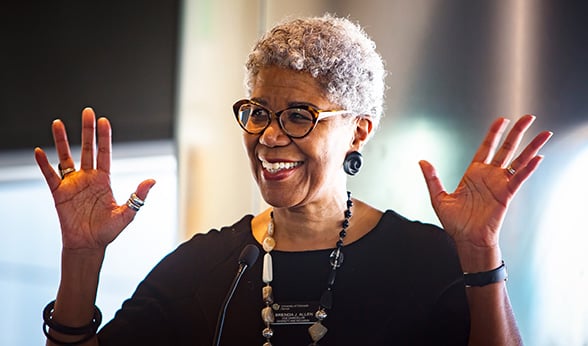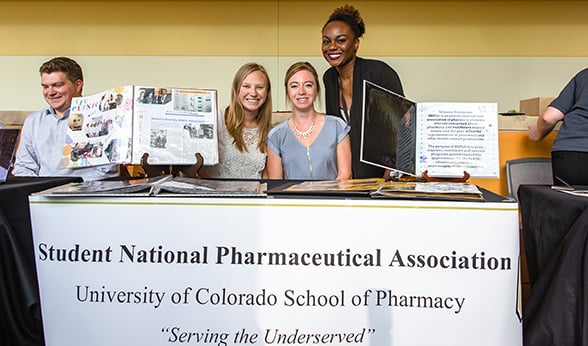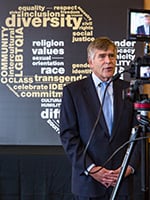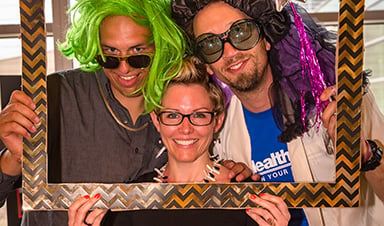Once they’d hung up their lab coats and pushed in their chairs, an impressive cross-section of the University of Colorado Anschutz Medical Campus came together after work recently, filling the Krugman Conference Hall in what organizers called a dynamic show of dedication and celebration.
Visitors to the first-ever Chancellor’s Diversity Showcase on April 23 were greeted by upward of 30 booths displaying a variety of endeavors to foster inclusivity and enhance diversity within the university. Topics ranged from redacting practices in hiring to lactation needs on campus, and the audience teemed with everyone from deans to students.
 Brenda J. Allen, PhD, welcomes the large turnout for the first Chancellor's Diversity Showcase on campus.
Brenda J. Allen, PhD, welcomes the large turnout for the first Chancellor's Diversity Showcase on campus.
“I believe we exceeded our goals,” said Brenda J. Allen, PhD, vice chancellor for diversity and inclusion for both the CU Anschutz and CU Denver campuses. “Not only were there a lot of people packing both the interior and exterior of Krugman Hall, but the energy was so positive, and I saw so many different kinds of people interacting with one another.” Allen suspects the success will lead to an annual event.
Three aims, three checkmarks
 Many student organizations joined in the Diversity Showcase, including CU-SNPhA, an educational and service group that strives to improve health in underserved communities.
Many student organizations joined in the Diversity Showcase, including CU-SNPhA, an educational and service group that strives to improve health in underserved communities.
The goals of the event were three-fold. “One was to exhibit and celebrate the rich variety of programs, initiatives and projects that we are engaged in at the CU Anschutz Medical Campus to accomplish our diversity and inclusion goals,” Allen said.
All of the major schools and colleges at CU Anschutz were represented in the showcase, along with numerous organizations, from the Community-Campus Partnership to the Center for Women’s Health Research. Every category in the university’s framework for diversity was also embodied in some way, including race, ethnicity, gender, nationality, religion, ability, sexual orientation and veteran and socioeconomic status.[cucalloutbox align="right" color="" class="" size=""]
IN THEIR WORDS:
“It’s important to foster and develop empathy and sympathy for other people, because that’s what is going to make the world a more diverse and inclusive place.” – Amanda Beyer-Purvis, Anschutz Inclusivity Alliance
“We’ve gone from having about 20 percent diversity in our student population to 56 percent for this year’s entering class. And last year’s class was 63 percent women, which was a high for us. It’s just a very diverse class in the truest sense.” – Kenneth Durgans, School of Dental Medicine
“We do have a booth at recruitment where we advertise our resources for the LGBT community. We are also in the orientation materials, so we do let students know we are a safe place.” – Claire Gillette, PRISM Gay-Straight Alliance
“We are all about population health, so we have to be in the community eliminating population disparities and advancing equity. That’s what we are trying to do.” – Cerise Hunt, Colorado School of Public Health
[/cucalloutbox]
“Another goal was to encourage interaction among the persons who are engaged in this work,” an aim seemingly met by the incessant buzz of voices among the 200-plus gatherers. “There were such a rich variety of the roles that represent our campus,” Allen said. “I was especially excited to see students interacting with each other in the section reserved for student groups that focus on diversity.”
 Chancellor Don Elliman takes part in an open-comment videotaping.
Chancellor Don Elliman takes part in an open-comment videotaping.
A third objective – to illuminate areas of possibility and encourage synergy and collaboration – was fueled by “idea walls,” which gathered a number of Post-its, and an opportunity to be videotaped, open to all participants for expressing experiences and thoughts surrounding diversity on campus. Both activities’ responses will become a part of a permanent webpage inspired by the event, Allen said.
A beginning, not an end
Looking out at the rows of booths lining the conference-room walls and stretching beyond the doors, Chancellor Don Elliman also indicated Allen’s team’s mission was accomplished. But it remains just a harbinger of what needs to come, he said.
“I had no idea that we would end up with what we have in front of us today: A graphic illustration of what we are trying to accomplish on this campus,” Elliman said. “I dearly wish that we didn’t have to have it. I wish that we were at a place today where people didn’t care what you looked like, what you thought, what your race or religion was,” he said.
Noting that he was inspired by the level of activity and the genuine enthusiasm in the room, Elliman said it was a great start. “But it’s by no means a finish line. I encourage you all to keep pushing.”
A push-start to more
 Participants have some fun at the Anschutz Inclusivity Alliance booth.
Participants have some fun at the Anschutz Inclusivity Alliance booth.
Much of the information shared by exhibitors and others will be posted on the new website, Allen said. “It will become one go-to place for people to have some sense of what’s going on at CU Anschutz in terms of diversity and inclusion.”
Many of the idea notes requested more training, particularly implicit bias programs, Allen said. And quite a few were centered on improved hiring and recruitment practices for diversifying faculty, student and staff populations. Allen, who said many people have asked her if she would organize a showcase again, assured that all suggestions would be taken seriously.
“It’s my mantra that we have to be systemic, strategic and sustainable in our efforts,” she said. “There is no magic pill or re-set button. It has to be something that really becomes part of who we are, embedded in our culture, and this type of event is a way to encourage and model that while also seeking guidance from those who care about these issues about what else we can do.”
